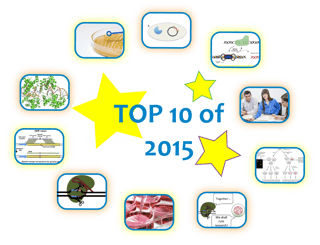 2015 has been an exciting year for the Addgene blog. We’ve released over 80 posts on a diverse array of topics pertinent to the research community, two eBooks (Management for Scientists and the Plasmids 101 2nd ed, the 3rd edition has now been released), and have started providing recorded interviews with Addgene community members. In addition we’ve experienced incredible growth with our readership expanding from ~10,000 users per month in November 2014 to ~30,000 users per month in November 2015.
2015 has been an exciting year for the Addgene blog. We’ve released over 80 posts on a diverse array of topics pertinent to the research community, two eBooks (Management for Scientists and the Plasmids 101 2nd ed, the 3rd edition has now been released), and have started providing recorded interviews with Addgene community members. In addition we’ve experienced incredible growth with our readership expanding from ~10,000 users per month in November 2014 to ~30,000 users per month in November 2015.
We will continue to provide you with more fascinating, informative, and actionable content in the coming years as we stay on top of the many developments in science and the plasmids, technologies, and researchers behind them. As part of our thanks to you for being a part of our community, we’ve curated a list of our 10 top-viewed posts from 2015 and encourage you to give them a read if you’ve missed them!
Breakdown of Addgene's top blog posts from 2015
Our most popular posts continue to be those from our Plasmids 101 and CRISPR 101 series. These posts aim to give researchers the background they need to get started using plasmids and the revolutionary CRISPR technology in their own labs. We’re overjoyed to provide you with these fantastic educational resources and will be sure to keep our eyes open for any new technologies that will bring about the next revolution in biological research.
We’re incredibly happy to see that one of our career posts has made it to the top of the list this year. While we love academic research, we hope we can help all researchers achieve happiness in their careers regardless of their end goals and believe the popularity of our career posts shows that we are doing just that.
Do you like the direction the blog has taken over the past year? Do you think there are topics we’re missing? We invite you to suggest topics you’d like to see on the blog or to contribute ideas for your own guest posts by e-mailing us at blog@addgene.org. Thank you again for a fantastic year and happy reading!
Top 10 blog posts of 2015
 1. CRISPR 101: Homology Directed Repair
1. CRISPR 101: Homology Directed Repair
Addgenie Chari Cortez explains some of the basic science behind homology directed repair (HDR) and how it’s used in CRISPR genome editing.
Cre recombinase can be used to generate inversions, deletions, and translocations. It also provides researchers with many different ways to control gene expression. Get the full scoop from Addgenie A. Max Juchheim in this post.
 3. Plasmids 101: E. coli Strains for Protein Production
3. Plasmids 101: E. coli Strains for Protein Production
 4. Plasmids 101: Blue-White Screening
4. Plasmids 101: Blue-White Screening
 5. Cpf1: A New Tool for CRISPR Genome Engineering
5. Cpf1: A New Tool for CRISPR Genome Engineering
 6. CRISPR 101: Non-homologous End Joining
6. CRISPR 101: Non-homologous End Joining
 7. Career Coaching for Scientists: Why and Where Do I Find One?
7. Career Coaching for Scientists: Why and Where Do I Find One?
- If you need help making a transition into a new job or maybe to an entirely new career path, a career coach might be able to help you. Head Addgenie Joanne Kamens explains what career coaches do and offers up some career coach suggestions.
 8. A Match Made in Heaven: CRISPR/Cas9 and AAV
8. A Match Made in Heaven: CRISPR/Cas9 and AAV
 9. CRISPR 101: Validating Your Genome Edit
9. CRISPR 101: Validating Your Genome Edit
 10. Plasmids 101: Control Plasmids
10. Plasmids 101: Control Plasmids
Happy Reading!
Resources on the Addgene Blog
- Download the Management for Scientists eBook
- Download the Plasmids 101 3rd Ed. eBook
- Read the Most Recent Plasmids 101, CRISPR 101, and Career Posts
Resources at Addgene
- Browse Our CRISPR Resources
- Learn More about Viral Vectors
- Browse the Repository
Topics: Addgene News







Leave a Comment